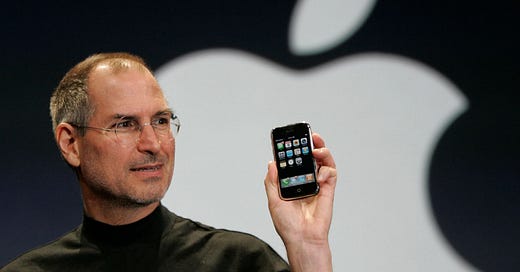This week, I had the pleasure of speaking to a room of soon-to-be grads and esteemed guests about “What Comes Next.” What follows are my remarks, edited for clarity.
In 2007, Steve Jobs held up the first iPhone and changed what we expect from technology. Not just what it could do, but how it should feel: swipe to unlock, pinch to zoom, pull to refresh. Designers responded with new gestures, new metaphors. And for a while, it felt like magic.
But those patterns became defaults. Swipe became muscle memory. The hamburger menu stuck around long past its prime. The medium matured, and the interactions calcified. What began as invention solidified into convention.
Today, we’re at a similar moment. Maybe even bigger. AI isn’t just another tool in the toolbox, it’s a shift in substrate. Like electricity, the internet, or the mobile phone, it changes the material conditions of what we can make. It’s a generational redesign of the tools we use to think, connect, and create.
A new playbook is being written
Here’s what excites me most: There is no playbook. You’re entering the field at a time when most people don’t know what they’re doing, but are pretending they do. Incumbents are scrambling to retrofit AI into their existing stack. We’re already seeing the reflex: sprinkle some AI on your roadmap, add a chatbot, auto-complete a few things.
But this moment is bigger than that. And you have the advantage. You’ve spent years learning to pay attention—to how things feel, to what they mean beneath the surface. You’ve practiced questioning assumptions, imagining new realities. You are especially poised to make the most of what comes next.
Because what we’re working with right now is more liquid than solid. And it’s in that fluid state—before the defaults congeal—that real invention is possible. The metaphors aren’t locked. The interfaces aren’t baked. The rules haven’t calcified. That means we get to choose what they become. Especially you.
You, who are not burdened by legacy roadmaps. You’re arriving clear-eyed, at the start of a new cycle—with taste, intuition, and better questions.
The new playbook will be written by people just like you. And I don’t know about you, but I want to be in that room.
Depth is the new scale
We’ve spent years prioritizing scale and reach, but what comes next isn’t about efficiency. It’s about emotion. Meaning. Resonance. It’s about making tools that feel less like dashboards and more like diaries. Interfaces that feel like conversations. Products that feel… personal.
That’s where design comes in. When the tools are this powerful, and the bar for creation is this low, design becomes the differentiator—not just whether something works, but whether it’s worth making.
This is the real opportunity of now: to prototype not just products, but principles. To lead with values, not just velocity. To care—openly, sincerely, on purpose.
You have the power
If you’re a designer right now, you have more power than any designer before you. Not just because of AI tools—though yes, those help—but because what’s being built today is more open-ended, more undefined, and more up for grabs than it’s been in decades. What we design now will set the tone for the next ten years. Maybe longer.
These are design problems. And we need people brave enough to go after them before it’s all locked in. Because the defaults will come. They always do. But right now, they’re still in flux. Still negotiable.
Yes, the system is confusing. Yes, job ladders are shaky. Yes, AI might automate the tasks junior designers used to cut their teeth on.
But that doesn’t make you irrelevant. It means the bar has changed. (And it will again.)
Design now is less about execution and more about discernment. You don’t need to be the fastest builder in the room, you just need to know what’s worth building. You need an opinion. And the willingness to ask better questions.
So, what do you do with that?
You build your own scaffolding.
You follow your weird curiosities.
You find your people.
You prototype your way through the fog.
This isn’t about getting it perfect. It’s about showing up. Sharing ideas before they’re ready. Shipping things that feel personal. Treating your practice like a lab. And when something lands—when someone tells you, “I didn’t know software could feel like that”—you’ll know you’re on to something.
The invitation stands: The defaults aren’t set. The canvas is still wet. What will you make of it? What comes next is up to you.
P.S. If you’re reading this thinking, “Yeah, I’ve got something weird and wonderful and a little half-baked that I want to build,” then maybe you’re in the right place at the right time. We’re building something called AIR, a 10-week, design-led accelerator based in NYC. $500K for 10%. Depth over scale. If that sounds like your vibe? You should apply.
Thank you, Nika Simovich Fisher and Andrew LeClair of the AAS & MPS Communication Design programs for the prompt. And shout out to Dev Makker for the event graphics—love ’em!








Yo!
What platform can I hit you up on for a short convo about all this stuff?
this was a nice push, much needed!